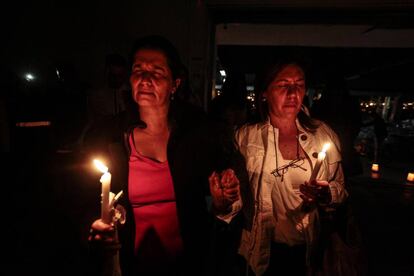Ecuador hit by strong tremors a month after deadly quake
One person was killed and over 80 injured by two shocks within 24 hours

One month after the deadly earthquake that left at least 660 people dead and some 16,000 injured, Ecuador continues to be hit by aftershocks.
On Wednesday, two powerful tremors, one registering more than 6 on the Richter scale, shook the northwest of the country, causing one death and 80 injuries as well as damage to buildings.
The first tremor hit in the early hours of Wednesday, around 10 kilometers underground and 58 kilometers south of the city of Esmeraldas on the country’s northwest coast, near the area of the 7.8-magnitude quake in April.
The Pacific Tsunami Alert Center has said there is no risk of a tsunami in the area.
The second tremor was felt around midday, local time, killing one person and injuring more than 80 others in the municipality of Tosagua, in the coastal province of Manabí, one of the areas hardest hit by the April quake.
Some tourists have returned to the area, more out of a sense of solidarity than to enjoy the beach, responding to a television and radio appeal
Authorities have called on people to stay calm and to be ready to evacuate their homes. The country’s Geophysical Institute says there were a further five aftershocks, including one registering 5.4, in the minutes following the tremor.
President Rafael Correa has admitted that the nation must be prepared to keep experiencing strong aftershocks.
Dealing with devastation
More than a month after the devastating quake, thousands of people in the towns and villages along the northwest coast of the country that were hardest hit continue to sleep in the streets, parks or shelters, while bulldozers demolish damaged homes and buildings at the rate of around 25 a day.
The town worst affected by the quake is Pedernales, also in Manabí, where 173 people died. Workers are still clearing up rubble, while many of the men and women who work in the local fishing and shrimp industry have yet to return to work. The local fish market remains closed. Tourism, the other major employer, will take much longer to recover. In all, the earthquake left almost 25,000 people without jobs, almost 18,000 in the worst-hit province, Manabí.
A few tourists have returned to the area, more out of a sense of solidarity than to enjoy the beach, responding to a television and radio appeal: “Your purchases help us keep going. We’re not leaving, we’re staying.” Some small restaurants have managed to open, but accommodation is scarce, with most of the seafront hotels badly damaged and closed.
Sign up for our newsletter
EL PAÍS English Edition is launching a weekly newsletter. Sign up today to receive a selection of our best stories in your inbox every Saturday morning. For full details about how to subscribe, click here.
“With bank loans, and not eating or doing anything else, we’ll rebuild these apartments we used to rent out to tourists,” says Mauricio Colasma, who owned a number of holiday rentals. He watches as a bulldozer demolishes the building he says took three years to build, while his wife turns her back and cries.
Rescue workers are still digging in the rubble of collapsed buildings, occasionally turning up bodies. The 661st victim, found earlier this week, was a 23-year-old woman. Her family identified her crushed and dismembered body by her purse, a gift from her brother. Her parents had continued searching in hospitals and health centers in the hope of finding her alive. Later, her brother told reporters that the body was damaged by the bulldozers, complaining of what he called “negligence” by the authorities in overseeing the rescue work.
The 73,000 people made homeless by the earthquake face a desperate situation. Many are dealing with the loss of loved ones, and must now find somewhere to live, as well as look for work.
“Many people are now beginning to realize that they have nothing: no family and no possessions. This creates post-traumatic processes that manifest themselves through behavioral changes that can often lead to arguments in the public shelters where they are staying: we have to find a way to channel that energy into something useful,” says Marcelo Cedillo, the head of an NGO that works with children.
In the meantime, Manta and Portoviejo, the two largest cities affected by the quake, are still without electricity, and there are more than 10,000 damaged or collapsed buildings, including 700 schools and colleges, along with more than 7,000 businesses unable to function properly.
English version by Nick Lyne.
Tu suscripción se está usando en otro dispositivo
¿Quieres añadir otro usuario a tu suscripción?
Si continúas leyendo en este dispositivo, no se podrá leer en el otro.
FlechaTu suscripción se está usando en otro dispositivo y solo puedes acceder a EL PAÍS desde un dispositivo a la vez.
Si quieres compartir tu cuenta, cambia tu suscripción a la modalidad Premium, así podrás añadir otro usuario. Cada uno accederá con su propia cuenta de email, lo que os permitirá personalizar vuestra experiencia en EL PAÍS.
¿Tienes una suscripción de empresa? Accede aquí para contratar más cuentas.
En el caso de no saber quién está usando tu cuenta, te recomendamos cambiar tu contraseña aquí.
Si decides continuar compartiendo tu cuenta, este mensaje se mostrará en tu dispositivo y en el de la otra persona que está usando tu cuenta de forma indefinida, afectando a tu experiencia de lectura. Puedes consultar aquí los términos y condiciones de la suscripción digital.
More information
Últimas noticias
Maduro pleads not guilty before the federal court in New York: ‘I am still the president of Venezuela’
A new test can detect Alzheimer’s from a finger prick
UN team enters Sudanese city of El Fasher after paramilitary massacre: ‘It’s like a ghost town’
A recipe for resistance: Indigenous peoples politicize their struggles from the kitchen
Most viewed
- Gilles Lipovetsky: ‘If you want to live better and fall in love, take Prozac, don’t look to philosophy’
- Alain Aspect, Nobel laureate in physics: ‘Einstein was so smart that he would have had to recognize quantum entanglement’
- Alvin Hellerstein, a 92-year-old judge appointed by Bill Clinton, to preside over Maduro’s trial in New York
- Why oil has been at the center of Venezuela-US conflicts for decades
- Cuba confirms death of 32 of its citizens in the US attack against Venezuela











































